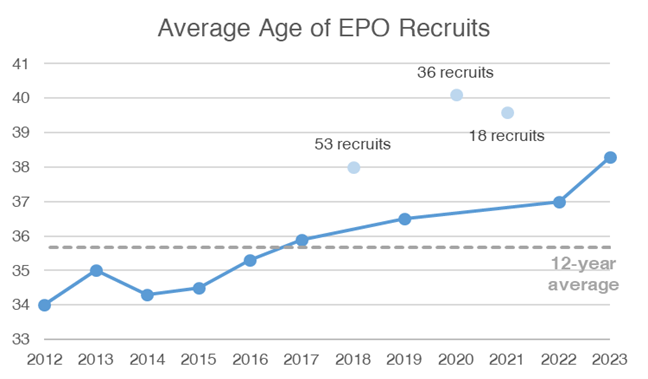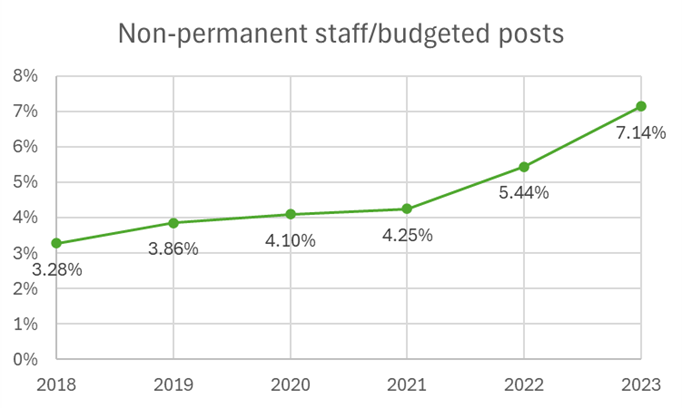In comparison to two years ago, the situation of job insecurity at the EPO has evolved little. SUEPO and the Staff Representation follow very closely the evolution of the situation

In 2022, I wrote an article for Agora 87 about Job Insecurity at the EPO, highlighting the concerns and issues that the staff was facing. After more than two years, it is now time to see how things have evolved at the EPO, and how those concerns and issues have been addressed by management. Fixed-term contracts were introduced for all new staff joining the EPO since 1st April 2018. The data quoted below is sourced from the publicly available Social Reports, the most recent edition of which comprises data accurate as of December 31st 2023.
How have things evolved since 2022?
With the reduced level of recruitment currently in force, meaning that the replacement rate is lower than 1:1, it is difficult to quantify the impact on the ability of the EPO to recruit since the introduction of fixed-term contracts. From the data that is available (see graph below), it is clear that the average age of recruits is increasing, which may have some impact from the move to fixed-term contracts. In addition, the number of new recruits that hold a PhD remains high at over 60%. Recently, the Office also changed the language policy to only requiring that candidates have a knowledge of one of the three official languages on recruitment in order to increase the pool of potential candidates. However, it seems that only in rare cases do colleagues join with knowledge of only one official language.

Graphique 1
What is the percentage of non-permanent staff at the EPO now?
The percentage of non-permanent staff as a percentage of the budgeted posts has increased from 5.44% in 2022 to 7.14% in 2023, and is believed to have further increased in 2024. This excludes the Young Professionals (YPs), as the Office does not count them towards the limit of 20% of non-permanent staff compared to the budgeted posts. The number of budgeted posts has been 7075 since 2018, despite the actual number of staff dropping to 6275 in 2023. Therefore, the percentage of non-permanent staff as a percentage of staff (i.e. filled posts) is significantly higher, at 10.5% at the end of 2023.

What happened to the proposals made by the SR in 2022/2023?
(Limitation of max contract duration from 10 to 5 years, 1 year notice period, clear extension and conversion criterias, balancing interests of staff and EPO, equality of treatment).
The president of the EPO did agree to implement the 1 year notice period, but refused to reduce the maximum contract duration from 10 years to 5 years, despite the arguments related to the national legal limits on fixed-term contracts in the host states, or the issue that under 1:1 recruitment conditions, the 20% limit of fixed-term contract staff would be reached before the 10 year period. No progress was made about balancing staff and EPO interests further or equality of treatment. The criteria of extension and conversion of contracts were supposedly improved with the introduction of a new Circular 405, but it is debateable whether any clarity was brought by this Circular.
The working group including management and staff representation on employment conditions is no longer active, but there is interest to revive the topic and keep the issue in the spotlight.
What about other non-permanent staff (Young professionals, IT staff, externals)?
There is no accessible data for external staff such as those working in IT, and as such we cannot track how the numbers evolve. Regarding the new Young professionals’ scheme, a type of internship/training scheme for recent graduates, the Office is taking full advantage of the possibility. Over 100 are recruited annually, and around 2/3 of the group have their contracts extended from the first year into the second and third years, despite this being originally estimated by the Office at 30%. These staff members often hold the required education level to be recruited as examiners or other staff members, and as such the possibility for the Office to recruit them into those roles, before waiting until the completion of the full 3 year training scheme should be considered. before offering examiner positions. The conversion rate from YP to fixed-term contract employee is still quite low, with only a handful from the 100 or so that enter the Office each year making the transition.

Present and future challenges for staff
As is the case in other organisations, non-permanent staff at the EPO face extra issues when compared to their permanent peers. These include; difficulty to start a family with an unknown future, particularly for women who would need to take extended maternity leave which could be considered to impact their chances of a renewed contract; additional production pressure being put on these colleagues who are no longer mostly concerned about their ability to achieve a career advancement, but rather to ensure that they keep their job with a contract extension and eventual conversion to permanent. This gives the management much more leverage to assert pressure than the rewards exercise; difficulty of these colleagues to speak up i.e. in appeals, joining staff representation, joining unions and actions, or even speaking against managerial harassment or inappropriate behaviour.
Conclusions
In comparison to two years ago, the situation of job insecurity at the EPO has evolved little. On one side, minor progresses were made concerning notice period and extension/conversion criterias of contracts, while on the other side, no progress has been recorded regarding the limitation of the maximum duration of fixed-term contracts, nor on balancing interest of staff and EPO and on equality of treatment. The non permanent staff still faces the same issues and challenges as in 2022. The number of staff with a fixed-term contract has increased from around 5% to 7%, and is supposedly still increasing without having created an obvious issue with recruitment so far. The present rapid expansion of the use of artificial intelligence at the EPO may represent a challenge that will possibly have an important impact on the job insecurity at the EPO and ultimately on the staff.
SUEPO and the Staff Representation follow very closely the evolution of the situation, to support the non-permanent staff to face their challenges, and are actively trying to reinstate a constructive dialogue with management to solve this recurrent issue.

Roberto RIGHETTI
ABOUT THE AUTHOR
Member of Bureau Federal USF and former member of Bureau SUEPO-TH